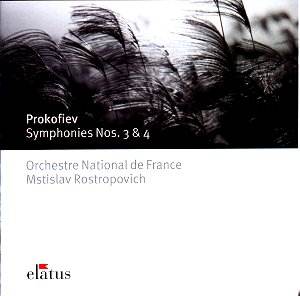Prokofiev's approach to the symphony varied considerably
from work to work, but something these two highly individual pieces
share in common is that each has its roots in previously composed
music for the stage. The Third Symphony is closely linked to the
opera The Fiery Angel, while the Fourth developed out of
the ballet The Prodigal Son. The composer returned to the
Fourth Symphony in the 1940s and undertook a thorough revision
of it, to the extent that it gained a new opus number: 112 compared
with the original 47.
Rostropovich recorded both versions of the Fourth
Symphony during the course of his complete cycle in the late 1980s,
and it is the revised score that is given here. However, in the
rather thin insert notes no mention is made of the revision, and
everything refers to the 1930 original.
The Third Symphony is typically dense in orchestral
textures. Prokofiev was at his most expressively intense and technically
complex during the 1920s, and the music is not at all easy to
bring off. It is undoubtedly the work of a master, but this performance
at any rate does not really catch fire. Those of Gennady Rozhdestvensky
(EMI) and Neemi Järvi (Chandos) are more satisfactory in
allowing the complex lines to combine in making their mark.
Part of the problem is the very ample acoustic,
or at least the impression of such. The sound is not particularly
well balanced and, for example, important string lines can be
lost when the power of the brass and percussion sets in during
climaxes. Whether it is this or Rostropovich's slow tempi (he
adds a full five minutes to Järvi's timing) that should shoulder
the blame for the curious lack of tension and momentum is not
clear, but lack of tension there certainly is. There is no lack
of force or power, however, since the passion and commitment are
never in doubt.
The Fourth Symphony has had a mixed press over
the years, and the fact that the composer chose to revise it so
thoroughly has in many ways encouraged its critics. Of the revised
version (recorded here), Prokofiev said: 'The previous material
has been preserved to some degree, but I have added so much that
this could almost be called my Seventh Symphony'. For this reason
he assigned the music a new opus number. In its new and longer
form, and with generally richer orchestration, it undoubtedly
gained from Prokofiev's experience in his Fifth and Sixth symphonies,
probably his greatest symphonic works. Be that as it may, it was
never performed in his lifetime, the premiere taking place only
in 1959, six years after his death.
The orchestration of the revised Fourth is more
varied than that of the Third Symphony, and this suits Rostropovich's
preference for slow tempi. Beyond that the same strictures apply,
and this music can gain from a lighter touch of balancing and
phrasing, not to mention the simple matter of faster tempi. Of
course there is more than one way of performing a masterpiece,
but if a choice needs be made, then Järvi's performance is
the one.
Terry Barfoot
